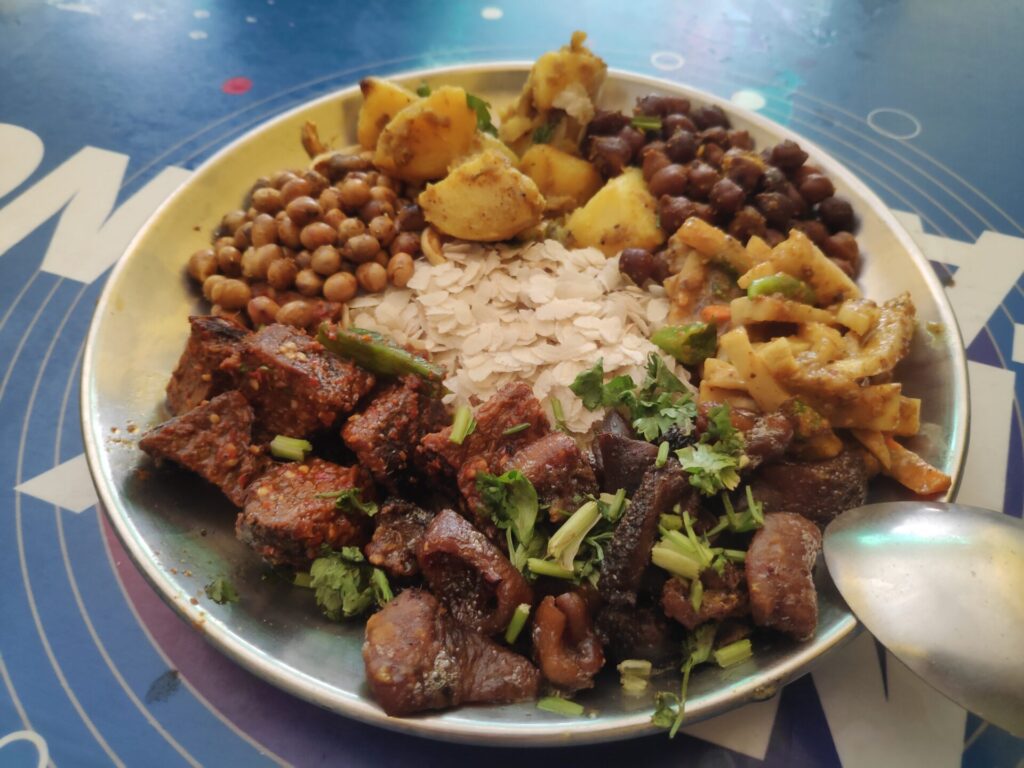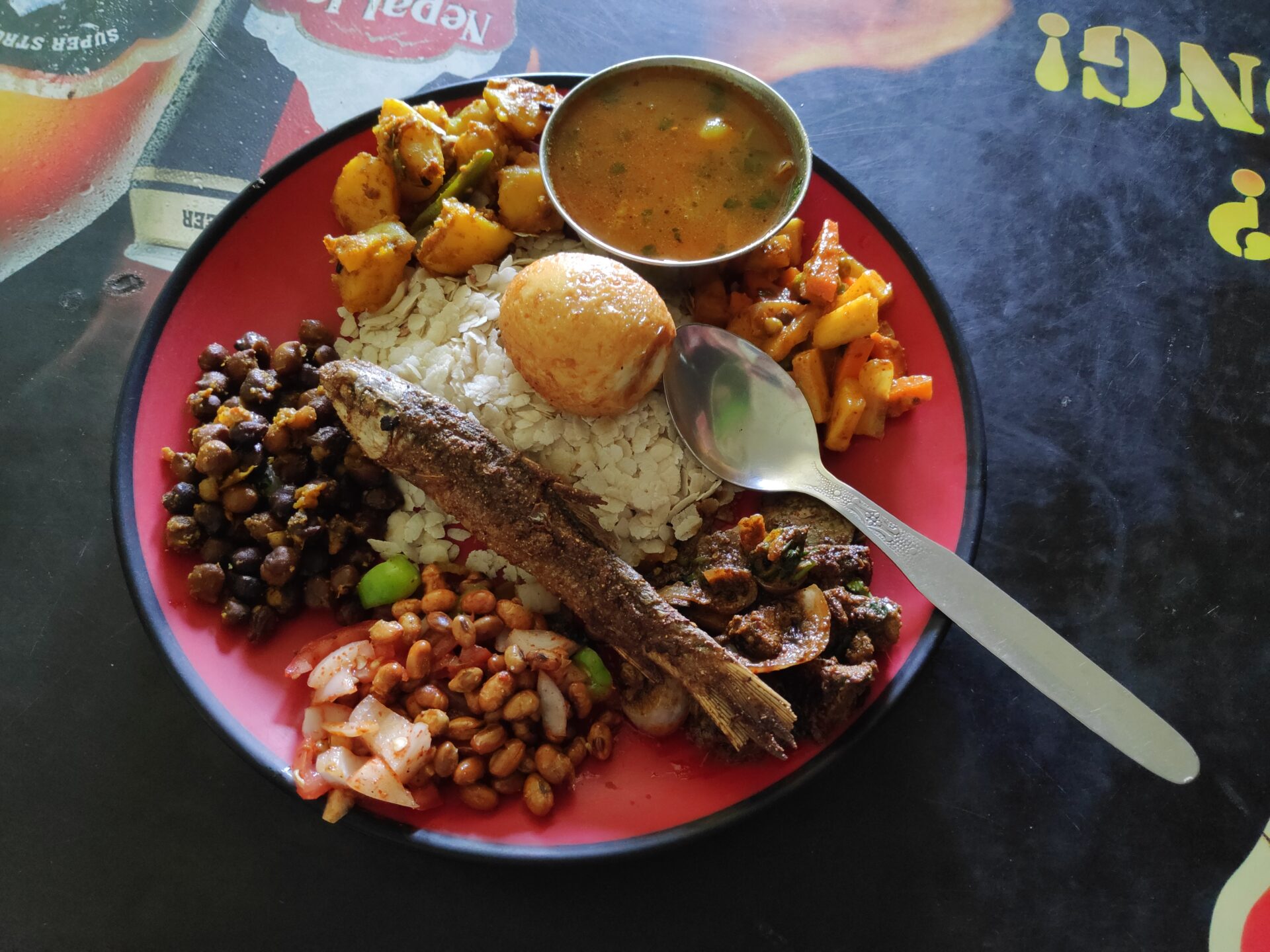Newari Khaja Set
The Newari Khaja Set is a traditional and popular Nepali snack that originated from the Newar community in Nepal. It is a set of various savory and sweet items served together on a plate. This delightful snack is commonly found in restaurants and eateries in Nepal, particularly in the capital city of Kathmandu.
The Newari Khaja Set is known for its diverse selection of food items, both vegetarian and non-vegetarian. It typically includes dishes like beef meat, soybean, pickle, mashed Bara (a type of lentil pancake), and more. The set is served with Chiura (flattened rice) and is often accompanied by a variety of chutneys and sauces to enhance the flavors.
One unique aspect of the Newari Khaja Set is the way it is presented. Traditionally, it is served on a leaf plate called “Bota,” which is made from the leaves of certain trees. This adds an authentic touch to the overall dining experience.
This snack holds great cultural and historical significance in Nepal, as it has been a part of the Newar community’s culinary traditions for centuries. It showcases the rich flavors and culinary expertise of the Nepali culture.
Preparing the Newari Khaja Set requires skill and attention to detail. The ingredients are carefully selected and cooked with various spices and seasonings to create a harmonious combination of flavors. Each item is prepared separately and then arranged together on the plate to create a visually appealing and mouthwatering meal.
Ingredients and Spices
Common Ingredients Used
Newari cuisine, native to the Kathmandu Valley, is known for its unique cultural practices and flavorful dishes. The Khaja Set is a popular and important part of Newari cuisine, often served during festivals, celebrations, and religious ceremonies. This article section will explore some of the common ingredients used in Newari cuisine, particularly in the Khaja Set.
- Lentils: Lentils play a significant role in Newari cuisine, and they are used in various dishes. One of the main components of the Khaja Set is Bara, a Nepali lentil cake made from black lentils. Lentils are also used in soups, curries, and snacks.
- Meat: Meat, especially buffalo and chicken, is commonly used in Newari cuisine. Chhoyala, another popular dish in the Khaja Set, is made by roasting buffalo meat, combining it with spices, and marinating it. Meat is also used in curries and other meat-based dishes.
- Potatoes: Potatoes are a versatile ingredient used in various Newari dishes. Aloo Chop, a deep-fried potato cutlet, is a common item in the Khaja Set. Potatoes are also used in curries, snacks, and pickles.
- Rice: Rice, particularly beaten rice, is used in traditional Newari dishes like Samay Baji. Samay Baji consists of beaten rice, boiled eggs, smoked fish, pickles, and other condiments. Rice is also used in other rice-based dishes and desserts.
- Spices: Newari cuisine is known for its flavorful and spicy dishes. Common spices used in Newari cuisine include ginger, garlic, turmeric, cumin, coriander, fenugreek, and mustard seeds. These spices add depth and aroma to the dishes.
- Pickles: Pickles are a common accompaniment to Newari meals. Pickles, known as achar, are made from various ingredients such as mangoes, tomatoes, radishes, and chilies. They provide a tangy and spicy flavor to the dishes.
- Yogurt: Yogurt, known as juju dhau, is a popular ingredient in Newari cuisine. It is often served as a side dish or used as a base for various curries and snacks. Juju dhau has a creamy and slightly sour taste.
These are just a few examples of the common ingredients used in Newari cuisine. Each dish in the Khaja Set and other Newari specialties has its unique combination of flavors and ingredients. Exploring Newari cuisine allows you to experience the rich cultural heritage and delicious flavors of the Kathmandu Valley.

Distinct Spices and Their Significance
Newari food is known for its distinct flavors and aromatic spices that add depth and richness to the dishes. The use of these spices is a significant aspect of Newari cuisine, as it enhances the taste and brings out the authentic flavors of the traditional recipes. Here are some of the distinct spices used in Newari food and their significance:
- Astafoieda: Astafoieda, also known as hing, is a pungent and aromatic spice that is derived from the resin of the Ferula plant. It is used in small quantities in Newari dishes to enhance the flavors and provide a unique earthy and onion-like taste. Astafoieda is believed to aid digestion and is often used in lentil dishes and pickles.
- Schezuan Pepper: Schezuan pepper, also known as timur in Nepal, is a unique spice with a citrusy and numbing effect on the tongue. It adds a distinct flavor and a mild spicy kick to the dishes. Schezuan pepper is commonly used in Newari momo, chhoyela, and other meat-based dishes.
- Black Salt: Black salt, also known as kala namak, is a mineral-rich salt that has a unique sulfurous flavor. It is widely used in Newari cuisine to add a tangy and slightly smoky taste to the dishes. Black salt is commonly used in chhoyela, aila, and various chutneys.
- Himalayan Pink Salt: Himalayan pink salt is a natural salt that is mined from the Himalayan mountains. It is known for its high mineral content and delicate flavor. Himalayan pink salt is used in Newari food to enhance the taste and bring out the natural flavors of the ingredients.
- Mustard: Mustard seeds and mustard oil are widely used in Newari cuisine for their pungent and sharp taste. Mustard oil is used for tempering and frying, while mustard seeds are ground into a paste to make various pickles and chutneys. The distinct flavor of mustard adds a zing to the dishes and complements the richness of meat and vegetables.
- Fenugreek Seeds: Fenugreek seeds, also known as methi, have a slightly bitter and nutty flavor. In Newari cuisine, fenugreek seeds are often roasted and ground to make a satay or spice mix. This spice mix is used in various dishes to add a unique aroma and flavor.
These distinct spices play an essential role in Newari food, elevating the taste and creating a culinary experience that is deeply rooted in tradition and culture. The skillful use of these spices by Newari chefs ensures that each dish is a harmonious blend of flavors, textures, and aromas that delight the senses.

